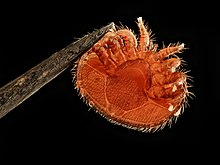瓦蟎
| 瓦蟎 | |
|---|---|

| |

| |
| 雌性瓦蟎成蟲的背部(上)和腹部(下)視圖 | |
| 科學分類 | |
| 界: | 動物界 Animalia |
| 門: | 節肢動物門 Arthropoda |
| 綱: | 蛛形綱 Arachnida |
| 目: | 中氣門蟎目 Mesostigmata |
| 科: | 瓦蟎科 Varroidae |
| 屬: | 瓦蟎屬 Varroa |
| 種: | 瓦蟎 V. destructor
|
| 二名法 | |
| Varroa destructor Anderson & Trueman, 2000[1]
| |
瓦蟎(學名:Varroa destructor),又稱狄斯瓦蟎、蜂蟹蟎,是蛛形綱瓦蟎科瓦蟎屬的一種生物,是蜜蜂的體外寄生蟲,以蜜蜂的幼蟲、 蛹及成蟲脂肪體為食獲取營養[2]。
生活史[編輯]
雄蟎生命周期較短,在交配後不久就會死亡,而雌蟎的生命周期相對較長[3]。雌蟎的生命周期可分為在幼蟲巢房內的繁殖期和在成年蜜蜂身上的游離期[4]。
入侵蜜蜂巢房後,標誌著雌蟎繁殖階段的開始[5]。在蜜蜂蛹的第二節腹板間,雌蟎會開一個孔以便取食蜜蜂脂肪體[2]。產卵則在巢房入侵後的約60至70小時開始,首先產下雄卵,之後每隔30分鐘產下一粒雌卵,一隻雌蟎的壽命期內通常會經歷3至7個產卵周期,產卵數量可達30粒[6]。卵圓扁平,紅棕色,長1-1.2毫米。
隨著蜜蜂發育成熟,雌蟎及其後代將與蜜蜂一同離開巢房,進入游離期[7]。在游離期間,雌蟎會附著在成年蜜蜂身上,利用蜜蜂的脂肪體為食。它們通過蜜蜂之間的物理接觸,寄生於新的宿主蜜蜂,並尋找進入育雛巢房繁殖的機會[3]。此外,雌蟎還能夠通過蜜蜂表皮烴類物質等來識別寄主,選擇最優的寄主進行寄生和繁殖[8]。
-
雄性瓦蟎成蟲
-
蜜蜂幼蟲上的瓦蟎
-
蜜蜂蛹上的瓦蟎
對蜜蜂的影響[編輯]
瓦蟎最初是東方蜜蜂(Apis cerana)的寄生蟲,後來轉移到了西方蜜蜂身上,並迅速傳播至全世界,成為養蜂業主要的寄生蟲害[2]。
被瓦蟎寄生的工蜂羽化後,平均體重相較於健康工蜂會輕6.3%至25%,而體重損失比例與瓦蟎數量呈正相關[3]。此外,狄斯瓦蟎攜帶的殘翅病毒(Deformed Wing Virus)會顯著縮短蜜蜂的壽命[9]。瓦蟎寄生對蜜蜂的神經系統造成干擾,影響其學習能力、認知記憶能力和行為,導致飛行能力下降、精子量減少,甚至死亡[3]。
瓦蟎是多種蜜蜂病毒的載體,尤其是殘翅病毒,其在瓦蟎體內繁殖後能夠大量傳播給蜂群其他個體[10]。在沒有瓦蟎的地區,蜜蜂病毒的感染率較低,但在瓦蟎侵染地區,蜜蜂病毒的感染率顯著增加[11]。瓦蟎攜帶的蜜蜂殘翅病毒是導致蜂群越冬死亡的主要病因之一[10][12]。
-
遭寄生的工蜂
-
翅膀變形
防治方法[編輯]
物理防治[編輯]
物理防治瓦蟎的方法主要包括細粉末處理、熱處理和分蜂處理等,然而研究表明物理防治的效率相對較低,且在實際應用中存在一定的困難[13]。一些研究指出,通過割除雄蜂巢房可以減少蜂群中瓦蟎的數量,因為瓦蟎更傾向於寄生於雄蜂的巢房以增加自身繁殖率[14][15]。
化學防治[編輯]

化學防治是控制瓦蟎數量的常用方法,主要採用殺蟎劑進行處理,包括雙甲蟎、蠅毒磷、氟氰胺菊酯和氟氯苯菊酯等,它們具有成本低、活性強、使用方便和高效的特點[16]。甲酸熏蒸法以及草酸也可以有效防治瓦蟎[3]。然而過度依賴和長期使用化學藥物可能會對蜜蜂產生負面影響[17],包括工蜂記憶力、採集能力和衛生行為能力的下降[18],以及對蜂王和雄蜂生殖健康的影響[19]。此外,化學藥物的使用還可能導致化學殘留物污染蜂產品[20],並增強瓦蟎的抗藥性[21]。
生物防治[編輯]
利用昆蟲致病性真菌防治瓦蟎是一種有效的生物防治方法。已經發現了40多種對瓦蟎具有抑制作用的真菌,例如輪枝孢菌、被毛孢屬、擬青黴屬、白僵菌屬、綠僵菌屬和彎頸霉屬等。然而,要有效提高生物防治效果,施用方式和環境都具有一定的要求,養蜂人需要具備一定的生物學知識。[3]
培育具有抗蟎特性的蜂種被認為是一種可持續的瓦蟎防治方法[3]。其中,瓦蟎敏感衛生行為是一種蜜蜂的抗蟎機制,如東方蜜蜂會激烈攪動身體以清除瓦蟎,從而不至於對整個蜂群造成嚴重危害[22]。通過雜交遺傳育種,可以獲得具有瓦蟎敏感衛生行為的抗蟎蜂種[23][3]。
RNA干擾技術[編輯]
通過對蜜蜂進行RNA干擾,可以沉默瓦蟎的基因表達,從而影響其繁殖並降低種群數量[24]。研究發現,某些基因編輯技術能夠改變蜜蜂的生理、行為和生長,增強其對病原體的抗性,並通過觸發蜂蟎RNA干擾反應來殺死蜜蜂身上的蜂蟎[3][25]。
參考資料[編輯]
- ^ Beaulieu, FréDéRic; Dowling, Ashley P. G.; Klompen, Hans; De Moraes, Gilberto J.; Walter, David Evans. Superorder Parasitiformes Reuter, 1909. In: Zhang, Z.-Q. (Ed.) Animal biodiversity: An outline of higher-level classification and survey of taxonomic richness. Zootaxa. 2011-12-23, 3148 (1). doi:10.11646/zootaxa.3148.1.23.
- ^ 2.0 2.1 2.2 Ramsey, SD; Ochoa, R; Bauchan, G; Gulbronson, C; Mowery, JD; Cohen, A; Lim, D; Joklik, J; Cicero, JM; Ellis, JD; Hawthorne, D; vanEngelsdorp, D. Varroa destructor feeds primarily on honey bee fat body tissue and not hemolymph.. Proceedings of the National Academy of Sciences of the United States of America. 2019-01-29, 116 (5): 1792–1801. PMID 30647116. doi:10.1073/pnas.1818371116.
- ^ 3.0 3.1 3.2 3.3 3.4 3.5 3.6 3.7 3.8 張立富; 韓日疇, 李文峰. 蜜蜂瓦螨敏感卫生行为研究进展. 環境昆蟲學報. 2023, 45 (3): 631–638 [2024-03-20].
- ^ Piou, V; Tabart, J; Urrutia, V; Hemptinne, JL; Vétillard, A. Impact of the Phoretic Phase on Reproduction and Damage Caused by Varroa destructor (Anderson and Trueman) to Its Host, the European Honey Bee (Apis mellifera L.).. PloS one. 2016, 11 (4): e0153482. PMID 27096154. doi:10.1371/journal.pone.0153482.
- ^ Garrido, P Melisa; Martin, Mariana L; Negri, Pedro; Eguaras, Martín J. A standardized method to extract and store haemolymph from Apis mellifera and the ectoparasite Varroa destructor for protein analysis. Journal of Apicultural Research. 2013-01, 52 (2): 67–68. doi:10.3896/IBRA.1.52.2.13.
- ^ 劉川冬; 於鶴,李江紅. 狄斯瓦螨的研究进展与防治. 中國蜂業. 2017, 68 (8): 17–19, 22 [2024-03-20].
- ^ Donzé, Gérard; Guerin, Patrick M. Behavioral attributes and parental care of Varroa mites parasitizing honeybee brood. Behavioral Ecology and Sociobiology. 1994-05, 34 (5): 305–319. doi:10.1007/BF00197001.
- ^ Rickli, M; Diehl, PA; Guerin, PM. Cuticle alkanes of honeybee larvae mediate arrestment of bee parasiteVarroa jacobsoni.. Journal of chemical ecology. 1994-09, 20 (9): 2437–53. PMID 24242816. doi:10.1007/BF02033212.
- ^ Richards, E. H.; Jones, Benjamin; Bowman, Alan. Salivary secretions from the honeybee mite, Varroa destructor: effects on insect haemocytes and preliminary biochemical characterization. Parasitology. 2011-04, 138 (5): 602–608. doi:10.1017/S0031182011000072.
- ^ 10.0 10.1 Genersch, E; Aubert, M. Emerging and re-emerging viruses of the honey bee (Apis mellifera L.).. Veterinary research. 2010-11, 41 (6): 54. PMID 20423694. doi:10.1051/vetres/2010027.
- ^ Martin, SJ; Highfield, AC; Brettell, L; Villalobos, EM; Budge, GE; Powell, M; Nikaido, S; Schroeder, DC. Global honey bee viral landscape altered by a parasitic mite.. Science (New York, N.Y.). 2012-06-08, 336 (6086): 1304–6. PMID 22679096. doi:10.1126/science.1220941.
- ^ Dainat, B; Evans, JD; Chen, YP; Gauthier, L; Neumann, P. Dead or alive: deformed wing virus and Varroa destructor reduce the life span of winter honeybees.. Applied and environmental microbiology. 2012-02, 78 (4): 981–7. PMID 22179240. doi:10.1128/AEM.06537-11.
- ^ 張禕; 韓日疇. 蜜蜂寄生螨—狄斯瓦螨的研究进展. 環境昆蟲學報. 2012, 34 (3): 345–353 [2024-03-20].
- ^ Calderone, NW. Evaluation of drone brood removal for management of Varroa destructor (Acari: Varroidae) in colonies of Apis mellifera (Hymenoptera: Apidae) in the northeastern United States.. Journal of economic entomology. 2005-06, 98 (3): 645–50. PMID 16022287. doi:10.1603/0022-0493-98.3.645.
- ^ Wantuch, Holly A.; Tarpy, David R. Removal of Drone Brood From Apis mellifera (Hymenoptera: Apidae) Colonies to Control Varroa destructor (Acari: Varroidae) and Retain Adult Drones. Journal of Economic Entomology. 2009-12-01, 102 (6): 2033–2040. doi:10.1603/029.102.0603.
- ^ Mullin, CA; Frazier, M; Frazier, JL; Ashcraft, S; Simonds, R; Vanengelsdorp, D; Pettis, JS. High levels of miticides and agrochemicals in North American apiaries: implications for honey bee health.. PloS one. 2010-03-19, 5 (3): e9754. PMID 20333298. doi:10.1371/journal.pone.0009754.
- ^ Tihelka, Erik. EFFECTS OF SYNTHETIC AND ORGANIC ACARICIDES ON HONEY BEE HEALTH: A REVIEW. SLOVENIAN VETERINARY RESEARCH. 2018-10-10, 55 (3). doi:10.26873/SVR-422-2017.
- ^ Rangel, Juliana; Tarpy, David R. The combined effects of miticides on the mating health of honey bee ( Apis mellifera L.) queens. Journal of Apicultural Research. 2015-05-27, 54 (3): 275–283. doi:10.1080/00218839.2016.1147218.
- ^ Gashout, HA; Guzman-Novoa, E; Goodwin, PH; Correa-Benítez, A. Impact of sublethal exposure to synthetic and natural acaricides on honey bee (Apis mellifera) memory and expression of genes related to memory.. Journal of insect physiology. 2020-02, 121: 104014. PMID 31923391. doi:10.1016/j.jinsphys.2020.104014.
- ^ Bogdanov, Stefan. Contaminants of bee products. Apidologie. 2006-01, 37 (1): 1–18. doi:10.1051/apido:2005043.
- ^ Rinkevich, FD. Detection of amitraz resistance and reduced treatment efficacy in the Varroa Mite, Varroa destructor, within commercial beekeeping operations.. PloS one. 2020, 15 (1): e0227264. PMID 31951619. doi:10.1371/journal.pone.0227264.
- ^ Harbo, John R.; Harris, Jeffrey W. Responses to Varroa by honey bees with different levels of Varroa Sensitive Hygiene. Journal of Apicultural Research. 2009-01, 48 (3): 156–161. doi:10.3896/IBRA.1.48.3.02.
- ^ Harbo, JR; Harris, JW. Resistance to Varroa destructor (Mesostigmata: Varroidae) when mite-resistant queen honey bees (Hymenoptera: Apidae) were free-mated with unselected drones.. Journal of economic entomology. 2001-12, 94 (6): 1319–23. PMID 11777031. doi:10.1603/0022-0493-94.6.1319.
- ^ Garbian, Y; Maori, E; Kalev, H; Shafir, S; Sela, I. Bidirectional transfer of RNAi between honey bee and Varroa destructor: Varroa gene silencing reduces Varroa population.. PLoS pathogens. 2012-12, 8 (12): e1003035. PMID 23308063. doi:10.1371/journal.ppat.1003035.
- ^ Leonard, SP; Powell, JE; Perutka, J; Geng, P; Heckmann, LC; Horak, RD; Davies, BW; Ellington, AD; Barrick, JE; Moran, NA. Engineered symbionts activate honey bee immunity and limit pathogens.. Science (New York, N.Y.). 2020-01-31, 367 (6477): 573–576. PMID 32001655. doi:10.1126/science.aax9039.
外部連結[編輯]
 維基共享資源上的相關多媒體資源:瓦蟎
維基共享資源上的相關多媒體資源:瓦蟎 維基物種上的相關資訊:瓦蟎
維基物種上的相關資訊:瓦蟎- Varroa mite (頁面存檔備份,存於網際網路檔案館) on the University of Florida / Institute of Food and Agricultural Sciences Featured Creatures website
- [1] (頁面存檔備份,存於網際網路檔案館)
- Tiny mite responsible for bee colony deaths. CTV News. March 3, 2010 [2015-08-19]. (原始內容存檔於2010-03-07).
- Beediseases Archive.is的存檔,存檔日期2013-06-16
| ||||||||||||||||||||||||||||||||||||||||||
|
|







